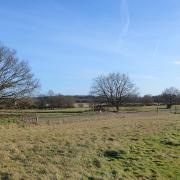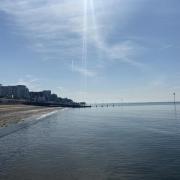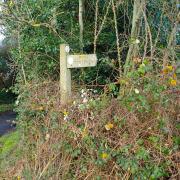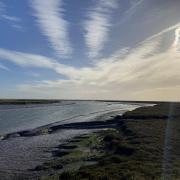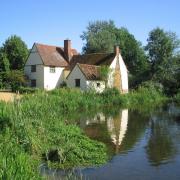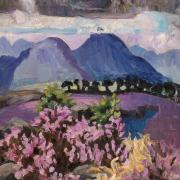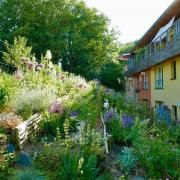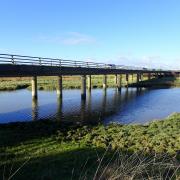Join Susanna Thornton as she takes her folding bike on a two-day adventure along Essex’s country lanes
Now is the perfect time of year to get out on a bike and enjoy the countryside, even if it has been months or years since you took to two wheels. A few weeks ago, I had a couple of days to spare, and decided I would try a simple, self-planned cycle ride in Essex.
All over the UK, there’s investment going into way-marked cycle routes, such as the National Cycle Network, and regional routes like the Coast to Coast. But beyond these routes, there’s huge scope to enjoy cycling simply out in the wide-open English countryside.
When I was a girl, I rode bikes a lot. Age six, I'd clank around the cul-de-sac on an old steel tricycle. Eventually I got a sparkly red Raleigh shopper. What a joy it was! I still remember the rush of air and the sense of freedom you get when riding a bike – even just to the local shops.
These days, I’ve moved on from my red Raleigh shopper. But I am not a lycra-clad mamil (middle-aged man in lycra). Or mawil perhaps? I pootle, rather than push it. I wear ordinary clothes, ordinary shoes, and I mostly ride a Brompton folding bike or a sturdy old hybrid that used to belong to my Mum.

For my Essex expedition, I decided to follow the River Roding from its mouth in east London, near where I live, to its source in Essex. The landscape would all be new to me. I was excited to see this green and – for us London-based folk – very accessible slice of south-west Essex.
In London, there’s a cycling and walking trail along the banks of the Roding. But once I was in Essex, I would not be able to ride along the water’s edge; there are only footpaths along the river, or no paths at all. So I decided I'd try zigzagging up the river valley on minor roads, taking in some of the Roding’s bridges and watermills. I planned to do about 50 miles in total, over a couple of leisurely days.
So, my plan sorted, I packed my gear, and at 7:30am one morning, I wheeled my bike into the London streets, and set off on my Essex adventure.
An hour or so later, trundling through an industrial estate in Barking, with lorries grinding past me, I really doubted myself. I felt silly cycling through an industrial estate on a folding bike with a tent. I wondered if the whole trip was a bad idea. In a forlorn little park by a massive waste depot, I climbed up some concrete steps. I was trying to see the mouth of the river, where the Roding meets the Thames.

At the top of the steps, I peeked over a wall. A huge expanse of blue water opened in front of me, shimmering in the morning sun. The Roding Flood Barrier, a huge arch, rose 60 metres above the Roding, here where its waters flowed into the Thames. It was magnificent. This should be a tourist spot! I thought to myself, dazzled by the sunlight on the water. Perhaps not. But planning my own route meant that ‘discoveries’ like this were my own, and that felt exciting and special.
I tootled up the Roding Valley Way trail, and in Buckhurst Hill I crossed into Essex. I came to the village of Abridge. Here was my first proper bridge over the Roding, three cute 18th-century arches in red brick, like a child’s drawing.
From Abridge, I headed up the lane to Lambourne, hoping to see the Roding Valley from above. It is not easy to get a good view of the shallow valley, but I enjoyed the green sweep of fields and hedgerows. I was amazed that all this was inside the M25.
Continuing my Roding zigzags, I took in Passingford Bridge and then Shonks Mill Bridge. The light was fading now. I went a short way along a bridle path and found a corner of a field to pitch my tent for the night. I cooked pasta and cheese and walnut sauce and watched the moon rise over Essex.

The next day, I took a long loop towards the tiny village of Norton Mandeville, along a beautiful unfenced track, with huge views over the open fields. I sat on the bank and had coffee from my flask, listening to the crows cawing in the trees. I could see the lorries on the A414, tiny and far away, in a different world.
At Fyfield, I enjoyed the view of the watermill over its peaceful millpond. There has been a mill on this spot since the Domesday Book was compiled in 1086.
A little further up the Roding, I pulled up at Waples Mill Farm. A muddy track leads to a small wooden bridge, where the river rushed noisily over a weir. Martin Ritchie, who farms this land, saw me standing at his gate with my bike and tent and kindly invited me in.
In two minutes flat, Ritchie covered his large farmhouse kitchen table with fascinating old photos for me to look at, showing the beautiful white weatherboarded farm building in times past. He told me about Isaac Mead, who farmed this land 100 years ago, and wrote a book, The Life Story of an Essex Lad. There was a photo of Isaac Mead himself, by the farm gate, a portly chap with a watch chain across his waistcoat.

Ritchie said he has recently established a pop-up campsite at the farm, on the meadow by the river. ‘We hope people will enjoy this beautiful spot,’ he said.
I waved goodbye, thinking what a treat it was to cycle slowly and stop to chat with people. The serendipity of my little self-planned route was a joy.
Now I was getting close to the end of my ride. The west Essex countryside had been perfect for pootling, a web of winding empty lanes, with pigeons flapping away out of the roadside trees and birds of prey rising from the branches above my head, before winging out across the open fields.

I ate a sandwich sitting on a bench at Margaret Roding, one of the eight villages here with ‘Roding’ in their name. Then I headed up to Mole Hill Green, to look for the source of the river. There was nothing really to see there, just a little old thatched cottage. But it was a good place to sit and sip a last coffee, before hopping on the train back to London.
Following the Roding had been a fascinating way to explore the Essex landscape from a different point of view. And planning my own cycle route had made the little discoveries along the way all the sweeter. Time to pull out a map (or an app), and have a pootle!
Tips for planning your own cycle route
- Try cycling apps and websites, such as Bikemaps or Komoot. These can give cycle route recommendations, avoiding main roads.
- You need a reliable bike, but it doesn’t have to be fancy. A folding bike is handy, so that you can easily combine cycling with public transport.
- There’s no need to ride far, be fast or push hard. It is not about the distance. Pause to chat, to look at a bird, a leaf, a view.
- Ordinary clothes and ordinary shoes are fine. Just make sure your trousers don’t have seams in the saddle area where they will rub, and if you have flappy trouser legs, tuck them in your socks so they don’t get caught in the chain.
- Be comfortable. Take a camping chair. Why not? And of course, a flask of coffee.
You may also like...
A walk in Kirby-le-Soken: https://www.greatbritishlife.co.uk/things-to-do/walks/circular-walk-kirby-le-soken-essex-9096442
15 wild days out in Essex: https://www.greatbritishlife.co.uk/things-to-do/wildlife/wild-days-out-essex-9151772




